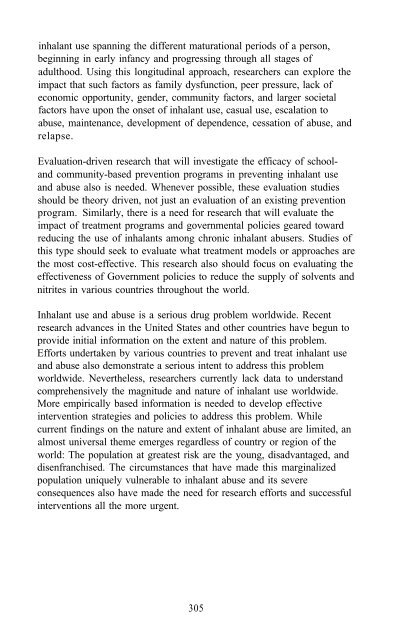Epidemiology of Inhalant Abuse - Archives - National Institute on ...
Epidemiology of Inhalant Abuse - Archives - National Institute on ...
Epidemiology of Inhalant Abuse - Archives - National Institute on ...
You also want an ePaper? Increase the reach of your titles
YUMPU automatically turns print PDFs into web optimized ePapers that Google loves.
inhalant use spanning the different maturati<strong>on</strong>al periods <str<strong>on</strong>g>of</str<strong>on</strong>g> a pers<strong>on</strong>,<br />
beginning in early infancy and progressing through all stages <str<strong>on</strong>g>of</str<strong>on</strong>g><br />
adulthood. Using this l<strong>on</strong>gitudinal approach, researchers can explore the<br />
impact that such factors as family dysfuncti<strong>on</strong>, peer pressure, lack <str<strong>on</strong>g>of</str<strong>on</strong>g><br />
ec<strong>on</strong>omic opportunity, gender, community factors, and larger societal<br />
factors have up<strong>on</strong> the <strong>on</strong>set <str<strong>on</strong>g>of</str<strong>on</strong>g> inhalant use, casual use, escalati<strong>on</strong> to<br />
abuse, maintenance, development <str<strong>on</strong>g>of</str<strong>on</strong>g> dependence, cessati<strong>on</strong> <str<strong>on</strong>g>of</str<strong>on</strong>g> abuse, and<br />
relapse.<br />
Evaluati<strong>on</strong>-driven research that will investigate the efficacy <str<strong>on</strong>g>of</str<strong>on</strong>g> schooland<br />
community-based preventi<strong>on</strong> programs in preventing inhalant use<br />
and abuse also is needed. Whenever possible, these evaluati<strong>on</strong> studies<br />
should be theory driven, not just an evaluati<strong>on</strong> <str<strong>on</strong>g>of</str<strong>on</strong>g> an existing preventi<strong>on</strong><br />
program. Similarly, there is a need for research that will evaluate the<br />
impact <str<strong>on</strong>g>of</str<strong>on</strong>g> treatment programs and governmental policies geared toward<br />
reducing the use <str<strong>on</strong>g>of</str<strong>on</strong>g> inhalants am<strong>on</strong>g chr<strong>on</strong>ic inhalant abusers. Studies <str<strong>on</strong>g>of</str<strong>on</strong>g><br />
this type should seek to evaluate what treatment models or approaches are<br />
the most cost-effective. This research also should focus <strong>on</strong> evaluating the<br />
effectiveness <str<strong>on</strong>g>of</str<strong>on</strong>g> Government policies to reduce the supply <str<strong>on</strong>g>of</str<strong>on</strong>g> solvents and<br />
nitrites in various countries throughout the world.<br />
<str<strong>on</strong>g>Inhalant</str<strong>on</strong>g> use and abuse is a serious drug problem worldwide. Recent<br />
research advances in the United States and other countries have begun to<br />
provide initial informati<strong>on</strong> <strong>on</strong> the extent and nature <str<strong>on</strong>g>of</str<strong>on</strong>g> this problem.<br />
Efforts undertaken by various countries to prevent and treat inhalant use<br />
and abuse also dem<strong>on</strong>strate a serious intent to address this problem<br />
worldwide. Nevertheless, researchers currently lack data to understand<br />
comprehensively the magnitude and nature <str<strong>on</strong>g>of</str<strong>on</strong>g> inhalant use worldwide.<br />
More empirically based informati<strong>on</strong> is needed to develop effective<br />
interventi<strong>on</strong> strategies and policies to address this problem. While<br />
current findings <strong>on</strong> the nature and extent <str<strong>on</strong>g>of</str<strong>on</strong>g> inhalant abuse are limited, an<br />
almost universal theme emerges regardless <str<strong>on</strong>g>of</str<strong>on</strong>g> country or regi<strong>on</strong> <str<strong>on</strong>g>of</str<strong>on</strong>g> the<br />
world: The populati<strong>on</strong> at greatest risk are the young, disadvantaged, and<br />
disenfranchised. The circumstances that have made this marginalized<br />
populati<strong>on</strong> uniquely vulnerable to inhalant abuse and its severe<br />
c<strong>on</strong>sequences also have made the need for research efforts and successful<br />
interventi<strong>on</strong>s all the more urgent.<br />
305
















